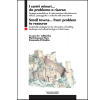I centri minori… da problema a risorsa. Strategie sostenibili per la valorizzazione del patrimonio edilizio, paesaggistico e culturale nelle aree interne
Synopsis
Pubblicato con licenza Creative Commons Attribuzione-Non Commerciale-Non opere derivate 4.0 Italia (CC-BY-NC-ND 4.0 IT) nella collana Nuova Serie di Architettura
Il volume raccoglie i contributi presentati alla Conferenza Internazionale dal titolo “I centri minori … da problema a risorsa. Strategie sostenibili per la valorizzazione del patrimonio edilizio, paesaggistico e culturale nelle aree interne”, svoltasi presso l’Università degli Studi di Salerno nei giorni 19 e 20 settembre 2019.
Docenti e ricercatori di università italiane ed estere hanno indagato sulle problematiche dello spopolamento e del declino delle piccole città e dei villaggi ed hanno evidenziato la necessità di una valorizzazione, nell’ottica di una nuova idea di conservazione e rigenerazione, che può produrre valore aggiunto, crescita e rinascita in contesti marginali, con il chiaro intento di svelare le potenzialità di luoghi marginali, di vedere cioè l’altra faccia della medaglia, quella delle opportunità e dell’esistenza di risorse inesplorate.
Dai risultati degli studi sviluppati si è compreso che è prefigurabile un’inversione di tendenza e che ci sono le condizioni per ipotizzare un ripopolamento delle aree interne.
Bisognerà fare i conti, tuttavia, con le dinamiche dell’economia globale, con le rivoluzioni tecnologiche, con l’uso delle macchine che tendono a sostituire l’uomo nel lavoro, con la digitalizzazione avanzata, nella consapevolezza che l’innovazione, come accaduto nel passato, certamente comporterà
in futuro un’evoluzione dei nostri modelli di vita e un riposizionamento dell’uomo sul territorio.
The book collects the contributions presented at the International Conference entitled “Small Towns…from problem to resource. Sustainable strategies for the valorization of building, landscape and cultural heritage in inland areas” held at the University of Salerno on 19th and 20th September 2019.
Professors and researchers from Italian and foreign universities have investigated the depopulation problems and the decline of small towns and villages and, at the same time, they have highlighted the opportunity/need for valorization, with a view to a new conservation and regeneration idea, which
can produce added value, growth and rebirth in marginal areas, with the clear objective of revealing the potential of marginal places, of seeing the other side of the coin, that one of opportunities and of the existence of unexplored resources.
From the results of the developed studies it was understood that a trend reversal is possible and that there are conditions to hypothesize a repopulation of the inland areas.
However, we will have to deal with the dynamics of the global economy, with technological revolutions, with the use of machines that will perhaps completely replace man in work, with advanced digitalization, in the awareness that innovation, as happened in the past, will certainly lead to an evolution of our life models and a repositioning of mankind within his environment in the future.
Downloads


